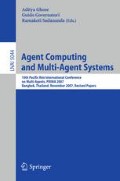Abstract
Networks of Evolutionary Processors (NEPs) –introduced in Castellanos et al. (2001)– are a new computing mechanism directly inspired in the behaviour of cell populations. NEPs, as well as generating devices, can be considered as bio-inspired context-sensitive multi-agent systems. This paper analyzes the agential features of NEPs and their special responses to the environment, which make this system specially suitable for description of Natural Language.
Access this chapter
Tax calculation will be finalised at checkout
Purchases are for personal use only
Preview
Unable to display preview. Download preview PDF.
References
Adleman, L.M.: Molecular Computation of Solutions to Combinatorial problems. Science 226, 1021–1024 (1994)
Castellanos, J., Martín-Vide, C., Mitrana, V., Sempere, J.M.: Solving NP-complet Problems with Networks of Evolutionary Processors. In: Mira, J., Prieto, A.G. (eds.) IWANN 2001. LNCS, vol. 2084, pp. 621–628. Springer, Heidelberg (2001)
Castellanos, J., Martín-Vide, C., Mitrana, V., Sempere, J.M.: Networks of Evolutionary Processors. Acta Informatica 39, 517–529 (2003)
Castellanos, J., Leupold, P., Mitrana, V.: On the Size Complexity of Hybrid Networks of Evolutionary Processors. Theoretical Computer Science 330(2), 205–220 (2005)
Chomsky, N.: Lectures on Government and Binding. The Pisa Lectures. Foris Publications, Dordrech (1981)
Chomsky, N.: Modular Approaches to the Study of Mind. San Diego State University Press (1984)
Csuhaj-Varjú, E., Dassow, J., Kelemen, J., Păun, G.: Grammar Systems. Gordon and Breach, London (1993)
Csuhaj-Varjú, E., Martín-Vide, C., Mitrana, V.: Hybrid Networks of Evolutionary Processors are Computationally Complete. Acta Informatica 41/4, 257–272 (2005)
Csuhaj-Varjú, E., Mitrana, V.: Evolutionary Systems: A Language Generating Device Inspired by Evolving Communities of Cells. Acta Informatica 36, 913–926 (2000)
Csuhaj-Varjú, E., Salomaa, A.: Networks of Parallel Language Processors. In: Păun, G., Salomaa, A. (eds.) New Trends in Formal Languages. LNCS, vol. 1218, pp. 299–318. Springer, Heidelberg (1997)
Dorigo, M., Stützle, T.: Ant Colony Optimization. MIT Press, Cambridge (2004)
Errico, L., Jesshope, C.: Towards a New Architecture for Symbolic Processing. In: Plander, I. (ed.) Artificial Intelligence and Information-Control Systems of Robots 1994, pp. 31–40. World Sci. Publ., Singapore (1994)
Everaert, M., Evers, A., Hybreqts, R., Trommelent, M. (eds.): Morphology and Modularity. In: Honour of Henk Schultink, Publications in Language Sciences 29, Foris (1988)
Farmer, A.K.: Modularity in Syntax: A Study of Japanese and English. MIT Press, Cambridge (1984)
Fodor, J.: The Modularity of Mind. MIT Press, Cambridge (1983)
Halle, M.: Prolegomena to a Theory of Word Formation. Linguistic Inquiry 4, 3–16 (1973)
Haykin, S.: Neural Networks: A Comprehensive Foundation. Prentice Hall, Englewood Cliffs (1999)
Hillis, W.D.: The Connection Machine. MIT Press, Cambridge (1985)
Jackendoff, R.: The Architecture of Language Faculty. MIT Press, Cambridge (1997)
Margenstern, M., Mitrana, V., Pérez-Jiménez, M.: Accepting Hybrid Networks of Evolutionary Processors. In: Ferreti, C., Mauri, G., Zandron, C. (eds.) DNA 10. Preliminary Proceedings, Milan, University of Milano-Biccoca, pp. 107–117 (2004)
McMahon, A.: Understanding Language Change. Cambridge University Press, Cambridge (1994)
Martín-Vide, C., Mitrana, V., Pérez-Jiménez, M., Sancho-Caparrini, F.: Hybrid Networks of Evolutionary Processors. In: Cantú-Paz, E., et al. (eds.) GECCO 2003. LNCS, vol. 2723, pp. 401–412. Springer, Heidelberg (2003)
Martín-Vide, C., Mitrana, V.: Networks of Evolutionary Processors: Results and Perspectives. In: Molecular Computational Models: Unconventional Approaches. Idea Group Publishing, Hershey (2004)
Martín-Vide, C., Pazos, J., Păun, G., Rodríguez-Patón, A.: A new class of symbolic abstract neural nets: Tissue P systems. In: H. Ibarra, O., Zhang, L. (eds.) COCOON 2002. LNCS, vol. 2387, pp. 290–299. Springer, Heidelberg (2002)
Pǎun, G.: Computing with Membranes. Journal of Computer and System Sciences 61, 108–143 (2000)
Pǎun, G., Rozenberg, G., Salomaa, A.: DNA Computing. New Computing Paradigms. Springer, Berlin (1998)
Rozenberg, G., Salomaa, A.: The mathematical theory of L Systems. Academic Press, New York (1980)
Sadock, J.M.: Autolexical Syntax. A Theory of Parallel Grammatical Representations. University of Chicago Press (1991)
Schmitt, L.: Theory of Genetic Algorithms. Theoretical Computer Science 259, 1–61 (2001)
Weinberg, A.: Modularity in the Syntactic Parser. In: Garfield, J.L. (ed.) Modularity in Knowledge Representation and Natural-Language Understanding, pp. 259–276. MIT Press, Cambridge (1987)
Author information
Authors and Affiliations
Editor information
Editors and Affiliations
Rights and permissions
Copyright information
© 2009 Springer-Verlag Berlin Heidelberg
About this paper
Cite this paper
Bel-Enguix, G., Jiménez-López, M.D. (2009). Multi-agent Simulation of Linguistic Processes: A NEPs Perspective. In: Ghose, A., Governatori, G., Sadananda, R. (eds) Agent Computing and Multi-Agent Systems. PRIMA 2007. Lecture Notes in Computer Science(), vol 5044. Springer, Berlin, Heidelberg. https://doi.org/10.1007/978-3-642-01639-4_27
Download citation
DOI: https://doi.org/10.1007/978-3-642-01639-4_27
Publisher Name: Springer, Berlin, Heidelberg
Print ISBN: 978-3-642-01638-7
Online ISBN: 978-3-642-01639-4
eBook Packages: Computer ScienceComputer Science (R0)

